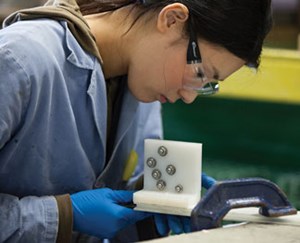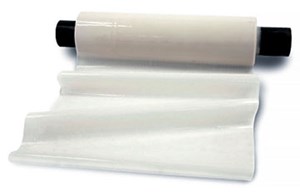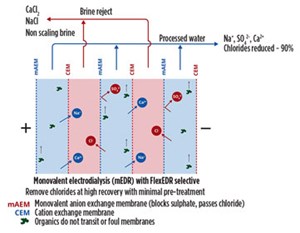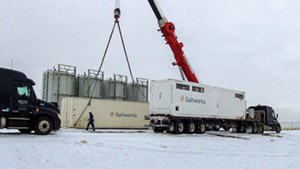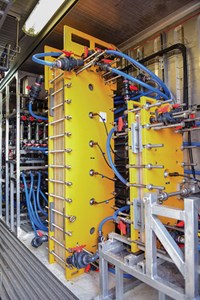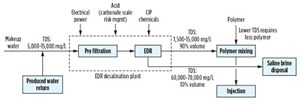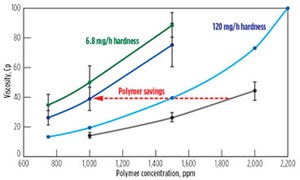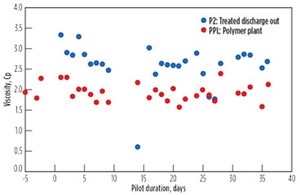Desalting EOR produced water to boost productivity
A new opportunity is on the horizon for EOR produced water treatment, via desalination, to boost productivity and lower costs. Testing results and economics from a recent field pilot suggest that operators could save over 50% on costs for polymer EOR floods while sending a recovery-optimized fluid downhole.
Saltworks Technologies’ Flex EDR desalination technology was deployed, with robust ion exchange membranes that can withstand harsh, produced water operating conditions. The pilot not only proved up-to-50% cost savings through polymer reduction, but also demonstrated highly preferential removal of divalent ions, which helped release oils in certain reservoirs.
TREATING PRODUCED WATER FOR REINJECTION
Waterflood EOR is known to increase oil yield from certain reservoirs, boosting production by up to 40%. This is done by pushing water through a reservoir to push out more oil. However, water picks up salt along the way, resulting in a saline produced water. Currently, EOR operators recycle produced water, but salinity rises with re-use. Eventually, the high-salinity produced water must be disposed, and lower salinity make-up water is needed. Injecting water of low salinity (2,000 to 8,000 mg/L total dissolved solids) with polymer to increase viscosity stimulates liberation of additional oil from the reservoir.
In polymer floods, the amount of polymer consumed to reach an optimal target viscosity increases with salinity. For example, a 4,000 m3/day produced water injection site may consume $5 million to $10 million in polymer/year. EOR operators combine strategies for managing produced water, such as adding more polymer to salty produced water, disposal, and extracting make-up freshwater to achieve lower-salinity injection water, or sacrifice production.
A 50-year-old technology was repurposed—EDR—to de-salt produced water and enable recycling with reduced polymer costs. Saltworks’ Flex EDR Organix (Fig. 1) employs proprietary ion exchange membranes that can withstand harsh produced water operating conditions and de-salt the produced water to any concentration that provides optimal performance specific to the reservoir.
Moreover, the EOR polymers present in the produced water do not foul or pass through the EDR membranes, but instead remain in the desalted water for reuse. In fact, some polymers are “re-activated” in the de-salted output, with viscosity increasing by almost double during desalination, and thereby enabling some recycling of original polymer. Results proved that lower total dissolved solid (TDS) of the injected water can result in over 50% polymer cost-savings. Polymer consumption increases with TDS, to reach a target viscosity goal. Therefore, de-salting the injected water can result in net savings, if desalination costs are lower than the incremental polymer consumption savings.
FLEX EDR FOR PRODUCED WATER DESALINATION
Although the most popular desalination technology on the market is reverse osmosis (RO), it struggles with the oily nature of produced water. Produced water contains hydrocarbons, including solvents that cause RO membranes to swell and foul. It is possible to remove hydrocarbons by pre-treatment, yet this can be cost-prohibitive. Evaporators are another technology available for treating produced water. However, they generally cost five-to-10-fold greater per unit of water treated, when compared with an RO unit. They are also larger, heavier and more energy-intensive, making them a poor fit for offshore EOR.
The solution in this work involves leveraging the second most-widely used membrane desalter, EDR. The technology underwent recent innovations in membrane composition, stack design, and process controls that enable its use on produced waters without extensive pre-treatment. EDR avoids the use of pressure difference across membranes, which is one contributor to fouling in an RO system, in favor of driving desalination by applying electricity across ion exchange membranes to separate ions by charge.
Saltworks recognized the opportunity to re-invent EDR for high-salinity and industrial applications, and has produced membranes and built systems that can operate in a harsh oilfield environment. The system also includes automated diagnosis and self-cleaning systems, which implement flushes and cleans before irreversible fouling or clogging, Fig. 2.
PROJECT SUMMARY/EQUIPMENT SETUP
A containerized mobile EDR treatment plant was dispatched to a Canadian EOR polymer flood field to prove the process, reliability and economics, Fig. 3. It consisted of full-scale components and was operated for 60 days, 24 hr/day. The plant operated reliably and continuously through major process upsets, including oil in water, spiking from 50 ppm to 1,000 ppm, and two severe weather events, including winds in excess of 62 mph and freezing conditions.
Figure 4 shows the Flex EDR Organix PFD for treating EOR produced water. Proprietary media filtration was used for pre-treatment, which could be back-washed and aggressively, chemically cleaned without degradation. The pre-treatment goal was to reduce particle distribution to less than 20 µm (goal of 15 µm), which prevents clogging in inlet manifolds built within the electrodialysis stack. Oil and hydrocarbon products do not need to be removed, however, coagulation of larger hydrocarbons and oil can occur within both the pre-treatment and electrodialysis stack. Coagulated oil that may accumulate over long periods of time was removed readily by either a backwards flush, or a more aggressive pH 11 wash. The high pH wash fluid was recycled and re-used multiple times. Backwash fluid was filtered via bag filters, and re-treated.
The plant treated produced water continuously with variable salinity, oil-in-water and organics. It desalted to three target salinity levels, to optimize polymer consumption, after which the desalted water was used in live polymer flood injection trials. Polymer savings varied from 40% to 60%, representing millions of dollars per year in electrical energy (OpEx) savings, and up to a 40% return on investment for the desalination unit capital and operating cost.
When accounting for the reduced disposal and freshwater withdrawal, the return on investment increases. Water recovery was consistently 90%, and resulted return on investment in the removal of almost all calcium, magnesium, barium and strontium as shown in Fig. 5, which can provide further benefits by reducing oil wettability in the reservoir.
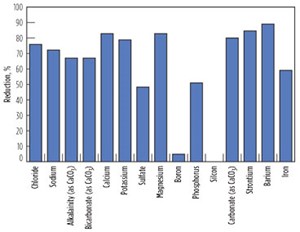
PROJECT ECONOMICS
EOR desalination could be economic, where polymer flood is employed to increase injected water viscosity and oil sweep. Polymer savings will vary widely from site to site, depending on desired final viscosity and chemical make-up. The viscosity of the desalted EOR produced water increases, which reduces the polymer requirements (lower operating costs) and increases oil recovery.
Figure 6 shows that desalted, produced water consumes less polymer to reach the target viscosity, with data suggesting 50% polymer savings. This offsets the cost of water treatment. Moreover, the residual polymer is reactivated, increasing the viscosity of treated water without adding any more polymer, coupled with the benefit of a higher-quality low-divalent injection fluid. Figure 7 shows that the viscosity of the treated water was higher than the produced water, when no polymer was added, proving residual polymer reactivation.
All site economics will vary, but as a guide, a typical 1,000-to-4,000 m3/day polymer injection site may consume $2 million to $10 million/year in polymer operating costs. For the sake of this work, and aligned with the pilot on 7,000 mg/L TDS inlet, it is assumed that polymer costs amount to $5.5/m3, injected without desalination. The 65% polymer cost savings could amount $2.5/m3 in polymer savings.
On the cost side of the equation, Table 1 highlights various scenarios, where different input concentrations of TDS are treated to a target of 1,500 mg/L TDS, and the change in capital and operating expenses/cubic meter of water treated, annualized over 10 years. The 7,000 mg/L scenario results in an estimated, total cost of ownership of roughly $1.5/m3, vs. the polymer cost savings presented above of $2.5/m3. The net result is 40% savings in total costs, based on polymer savings alone.
It is emphasized that every case is different, and at higher TDS inlets, the economics of desalination vs. polymer savings need to be checked. Although polymer savings increase at higher TDS inlets, capital and operating expenses also increase with greater changes in TDS concentrations. This is because EDR operates by mass flux of ions through membranes, and therefore a greater change in TDS increases mass flux, which increases both membrane area (CapEx) and OpEx. Every site will have its optimal economic “sweet spot” for desalination rate vs. polymer consumption, which can be determined by off-site pilot tests (bench tests) with relative ease.
CONCLUSION
With EOR set to increase its share of global oil production in the coming years, offering economic options for operators to improve their recovery methods will help improve EOR yields from existing wells at lower costs. In turn, this maximizes value from existing assets, and lowers the net cost of production per bbl of oil. Desalinating produced water from polymer flooding EOR offers strong potential to lower the cost of production, while also reducing water use and disposal.
Until now, conventional membrane technologies faced the challenge of overcoming the harsh operating conditions and hydrocarbons found in EOR. Recent innovations in EDR have proven early success to withstand EOR in-field operating conditions, and desalinate produced water with a possible 40% return on investment. Next steps include a permanent installation operating at a higher capacity and for a longer period of time, as well as investigation of economics desalting high TDS inlets, offshore EOR produced water, and possible benefits in non-polymer flood EOR fields.
Offshore EOR offers a particularly interesting 100% water recovery option while desalting. Since the system consists of industrially available technology that has been practiced widely in other industries, as well as being modular and mobile, implementation can be rapid and technology risk can be managed. This work demonstrates that the potential prize is large, both economically and environmentally. ![]()
- Advancing offshore decarbonization through electrification of FPSOs (March 2024)
- What's new in production (February 2024)
- Subsea technology- Corrosion monitoring: From failure to success (February 2024)
- U.S. operators reduce activity as crude prices plunge (February 2024)
- U.S. producing gas wells increase despite low prices (February 2024)
- U.S. oil and natural gas production hits record highs (February 2024)

